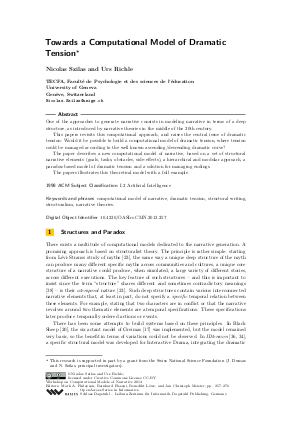Towards a Computational Model of Dramatic Tension
Authors Nicolas Szilas, Urs Richle
-
Part of:
Volume:
2013 Workshop on Computational Models of Narrative (CMN 2013)
Part of: Series: Open Access Series in Informatics (OASIcs) - License:
 Creative Commons Attribution 3.0 Unported license
Creative Commons Attribution 3.0 Unported license
- Publication Date: 2013-08-02
File

PDF
OASIcs.CMN.2013.257.pdf
- Filesize: 0.66 MB
- 20 pages
Document Identifiers
Subject Classification
Keywords
- computational model of narrative
- dramatic tension
- structural writing
- structuralism
- narrative theories
Metrics
- Access Statistics
-
Total Accesses (updated on a weekly basis)
0PDF Downloads0Metadata Views
Abstract
One of the approaches to generate narrative consists in modeling narrative in terms of a deep structure, as introduced by narrative theories in the middle of the 20th century. This papers revisits this computational approach, and raises the central issue of dramatic tension: Would it be possible to build a computational model of dramatic tension, where tension could be managed according to the well known ascending/descending dramatic curve? The paper describes a new computational model of narrative, based on a set of structural narrative elements (goals, tasks, obstacles, side-effects), a hierarchical and modular approach, a paradox-based model of dramatic tension and a solution for managing endings. The papers illustrates this theoretical model with a full example.
Cite As Get BibTex
Nicolas Szilas and Urs Richle. Towards a Computational Model of Dramatic Tension. In 2013 Workshop on Computational Models of Narrative. Open Access Series in Informatics (OASIcs), Volume 32, pp. 257-276, Schloss Dagstuhl – Leibniz-Zentrum für Informatik (2013)
https://doi.org/10.4230/OASIcs.CMN.2013.257
BibTex
@InProceedings{szilas_et_al:OASIcs.CMN.2013.257,
author = {Szilas, Nicolas and Richle, Urs},
title = {{Towards a Computational Model of Dramatic Tension}},
booktitle = {2013 Workshop on Computational Models of Narrative},
pages = {257--276},
series = {Open Access Series in Informatics (OASIcs)},
ISBN = {978-3-939897-57-6},
ISSN = {2190-6807},
year = {2013},
volume = {32},
editor = {Finlayson, Mark A. and Fisseni, Bernhard and L\"{o}we, Benedikt and Meister, Jan Christoph},
publisher = {Schloss Dagstuhl -- Leibniz-Zentrum f{\"u}r Informatik},
address = {Dagstuhl, Germany},
URL = {https://drops.dagstuhl.de/entities/document/10.4230/OASIcs.CMN.2013.257},
URN = {urn:nbn:de:0030-drops-41647},
doi = {10.4230/OASIcs.CMN.2013.257},
annote = {Keywords: computational model of narrative, dramatic tension, structural writing, structuralism, narrative theories}
}
